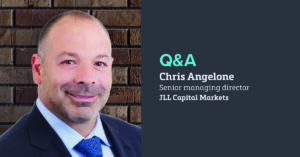As 2022 comes to a close and all eyes turn toward the new year, the commercial real estate market remains in flux. Interest rates continue to rise as the Federal Reserve pushes forward with its agenda to curb inflation. This past November, the Fed completed a fourth consecutive hike of 75 basis points, pushing the federal funds rate to a range of 3.75% to 4%, its highest level since 2008.
There is no definitive end to the current cycle of increases. How this policy will impact the U.S. economy going forward is one of the major issues that members of the commercial mortgage industry will have to decipher as they make plans for running their businesses in 2023.
Fed Chair Jerome Powell is following in the footsteps of one of his predecessors, Paul Volcker. For those unfamiliar with Volcker, he led the Fed’s board of governors from 1979 to 1987 and successfully reduced inflation from a peak of 14.8% in 1980 to less than 3% by 1983.
This reduction, however, didn’t come without pain to the national economy. Volcker raised the federal funds rate from an average of 11.2% in 1979 to 20% by June 1981, with the prime rate peaking at 21.5% during this period. This led to a pair of recessions from 1980 to 1982 and an unemployment rate in excess of 10%.
Although Volcker was widely criticized at the time for his stance to combat inflation, he was widely heralded as the shepherd of a booming economy that resulted from his policy decisions in the coming years. It appears that Powell is looking to mirror the dramatic and controversial tactics of Volcker in the near future, with the hope that inflation will be quashed and long-term economic growth will follow.
Whether this is the right path will be a debate for historians down the road. The resulting impacts, however, will continue to be dramatic for the commercial and residential real estate finance industries in 2023. The pressure on the real estate sector will continue until the Fed chooses to reverse course.
The Fed’s mistake
The year 2021 was a boon for commercial and residential real estate. A low interest rate environment led to strong demand in both sectors, despite the lingering COVID-19 pandemic. Last year started off in the same manner until prices began to rise quickly. What Powell first deemed to be “transitory” inflation was later determined to be a far bigger problem.
Inflation is an increase in the prices of goods and services. If supply cannot meet demand, prices rise. If supply is suppressed, such as in the case of the pandemic-related supply chain issues, prices rise. If supply is delayed or costs more to ship, prices rise. All of these, in one way or another, have contributed to a 40-year peak in the U.S. inflation rate.
The mischaracterization of inflation put the Fed in the position of playing catch-up after the first quarter of 2022, leading to a series of unprecedented rate hikes that shook the markets. Quite simply, the Fed got it wrong initially. Officials then had to impose larger rate hikes more quickly than the markets could contend with.
The goal of these rate hikes was to curb demand and reduce the costs of food, gas, rent and other essential expenses. But the negative effects on the real estate sectors are a byproduct of these policies. There’s an argument that the “blunt instrument” of rate increases is as destructive as it is warranted.
Depressed markets
Even though much of the pandemic- related supply chain issues have dissipated, the effects on pricing have remained. Economics 101 teaches that the simple answer to offset price increases is to ramp up supply in order to stabilize prices. But that is not necessarily in the best interests of for-profit companies, and they will hold out until consumers push back.
Commercial mortgages are priced using an index (such as the prime rate or U.S. Treasury) plus a margin. The lender chooses the index and determines the margin. Once these indexes rise, commercial mortgage rates rise along with them. In turn, this has an impact on cash flows, net operating incomes and debt-service-coverage ratios, resulting in fewer deals being approved and fewer investors willing to enter the market. It also increases capitalization rates and results in lower prices.
In the residential housing sector, Powell has made his belief clear that the market was overheated — that supply and demand needed to become more balanced, as opposed to the frenetic demand that greatly outstripped supply early in the pandemic. Demand for owner-occupied housing has waned, but prices remain elevated in certain pockets of the market.
In the commercial real estate sector, rising rents (a core component of the consumer price index) are benefiting multifamily owners. Hospitality assets also continue to flourish as pent-up demand created by the pandemic has led to travel-related sectors (including airlines) reaping the benefits. Travel activity has largely returned to pre-pandemic levels.
The office sector suffered early in the pandemic as many companies shifted to a remote-work environment. While this shift started to reverse in the second half of 2022, the fact that companies are now laying off employees could result in a backward step for office owners. Expect landlords to offer rent concessions to offset any decrease in demand. This may include steeper decreases for Class B and C properties when compared to Class A properties.
Looming layoffs?
How will all of this continue to play out in 2023? Making projections on the economy and its impact on real estate is difficult. As the old joke goes, if you get five economists in a room to predict the future, you will get seven different opinions.
It appears that rates will rise modestly in early 2023. Demand for commercial real estate will remain depressed as inflation lingers and the Fed stays on its current course. While rates will stay high to combat inflation (which will continue to dampen demand across the residential and commercial real estate sectors), the multifamily and hospitality segments are poised to remain strong.
Owner-occupied purchases may increase as business owners are likely to find better pricing for properties to house their companies rather than paying rent. This was a common phenomenon during the latter half of 2022.
Expect lenders to push for owner-occupied transactions since they allow for the ability to cross-sell additional products (e.g., merchant services). They also encourage the creation of business operating accounts and depository relationships. Many lenders will look to focus on U.S. Small Business Administration loans to offset risk. Should the economy officially enter a recession, which is highly likely in 2023, it’s expected to be a short and shallow one. As a result, investors will become more able to “cherry pick” attractive properties to purchase.
Even if the recession is brief, however, it could prove to be difficult for mortgage originators. Many lenders will lay off employees in their origination divisions due to reduced sales volumes. In the residential sector, it’s possible that many nonconforming lenders will fall. Operational staff at larger lenders could be decimated and a game of “musical chairs” may play out as those being laid off seek a new employer in the same field. Many will leave the mortgage industry entirely as origination activity probably won’t bounce back enough to warrant the hiring of new employees until 2024 or 2025.
●●●
The real estate and mortgage industries may suffer further before they get better, and 2023 could prove to be a lost year for the residential and commercial sectors alike. But even if this dire prediction comes true, don’t lose heart. Industry professionals who have the knowledge, experience and wherewithal to survive (and even thrive) in this environment will be rewarded when the market emerges from these difficult times and commercial real estate begins to flourish again. ●
Author
-

Rob Diodato is the president of York Commercial Finance, a commercial mortgage advisory company with offices in Dallas and New York. Diodato arranges financing for commercial real estate transactions nationwide for all property types. Diodato has more than 26 years of experience in the commercial and residential mortgage industries.





